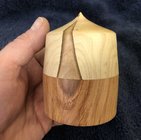Just turned this small lidded box using 'scraps' of laurel (top) and cherry (bottom). Wood was very dry. I had a lot of difficulty getting a smooth surface using a 1" straight (flat?) skew. I kept getting tear-out of long fibers and eventually went to a 3/4" gouge. I'm happy enough with the end product, but I was aiming for straight lines which are much easier to achieve with a skew.
What am I doing wrong? Angle of approach did not seem to make a difference. Perhaps how I've sharpened the skew? How much does the blade angle matter with dryer wood?

What am I doing wrong? Angle of approach did not seem to make a difference. Perhaps how I've sharpened the skew? How much does the blade angle matter with dryer wood?

